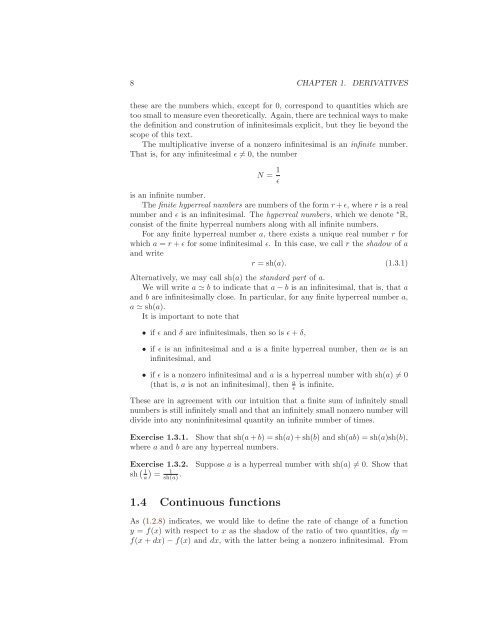Yet Another Calculus Text, 2007a
Yet Another Calculus Text, 2007a
Yet Another Calculus Text, 2007a
Create successful ePaper yourself
Turn your PDF publications into a flip-book with our unique Google optimized e-Paper software.
8 CHAPTER 1. DERIVATIVES<br />
these are the numbers which, except for 0, correspond to quantities which are<br />
too small to measure even theoretically. Again, there are technical ways to make<br />
the definition and constrution of infinitesimals explicit, but they lie beyond the<br />
scopeofthistext.<br />
The multiplicative inverse of a nonzero infinitesimal is an infinite number.<br />
That is, for any infinitesimal ɛ ≠0,thenumber<br />
N = 1 ɛ<br />
is an infinite number.<br />
The finite hyperreal numbers are numbers of the form r + ɛ, wherer is a real<br />
number and ɛ is an infinitesimal. The hyperreal numbers, which we denote ∗ R,<br />
consist of the finite hyperreal numbers along with all infinite numbers.<br />
For any finite hyperreal number a, there exists a unique real number r for<br />
which a = r + ɛ for some infinitesimal ɛ. In this case, we call r the shadow of a<br />
and write<br />
r =sh(a). (1.3.1)<br />
Alternatively, we may call sh(a) thestandard part of a.<br />
We will write a ≃ b to indicate that a − b is an infinitesimal, that is, that a<br />
and b are infinitesimally close. In particular, for any finite hyperreal number a,<br />
a ≃ sh(a).<br />
It is important to note that<br />
• if ɛ and δ are infinitesimals, then so is ɛ + δ,<br />
• if ɛ is an infinitesimal and a is a finite hyperreal number, then aɛ is an<br />
infinitesimal, and<br />
• if ɛ is a nonzero infinitesimal and a is a hyperreal number with sh(a) ≠0<br />
(that is, a is not an infinitesimal), then a ɛ<br />
is infinite.<br />
These are in agreement with our intuition that a finite sum of infinitely small<br />
numbers is still infinitely small and that an infinitely small nonzero number will<br />
divide into any noninfinitesimal quantity an infinite number of times.<br />
Exercise 1.3.1. Show that sh(a + b) =sh(a)+sh(b) andsh(ab) =sh(a)sh(b),<br />
where a and b are any hyperreal numbers.<br />
Exercise 1.3.2.<br />
sh ( )<br />
1<br />
a =<br />
1<br />
sh(a) .<br />
Suppose a is a hyperreal number with sh(a) ≠ 0. Show that<br />
1.4 Continuous functions<br />
As (1.2.8) indicates, we would like to define the rate of change of a function<br />
y = f(x) withrespecttox as the shadow of the ratio of two quantities, dy =<br />
f(x + dx) − f(x) anddx, with the latter being a nonzero infinitesimal. From


















